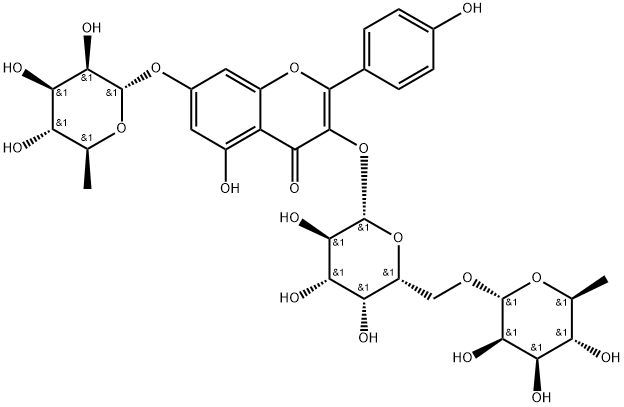Robinin
Synonym(s):Kaempferol 3-O-robinoside-7-O-rhamnoside
- CAS NO.:301-19-9
- Empirical Formula: C33H40O19
- Molecular Weight: 740.66
- MDL number: MFCD00016940
- EINECS: 206-113-3
- SAFETY DATA SHEET (SDS)
- Update Date: 2025-12-25 11:31:46

What is Robinin?
Chemical properties
Robinin is a flavone belonging to the flavonol glycosides occurring in Robinia species, e. g., Robinia pseudoacacia (Fabaceae) and in Pueraria and Vigna species (Fabaceae). Robinin has been reported to have antibacterial activity.
Definition
ChEBI: Robinin is a glycosyloxyflavone that is kaempherol substituted by a 6-O-(6-deoxy-alpha-L-mannopyranosyl)-beta-D-galactopyranosyl residue at position 3 and a 6-deoxy-alpha-L-mannopyranosyl residue at position 7 via a glycosidic linkage. It has a role as a plant metabolite. It is a glycosyloxyflavone and a dihydroxyflavone. It is functionally related to a kaempferol.
Properties of Robinin
| Melting point: | 194-195°C |
| Boiling point: | 1064.4±65.0 °C(Predicted) |
| Density | 1.74±0.1 g/cm3(Predicted) |
| storage temp. | -20°C |
| solubility | Soluble in hot water |
| form | powder |
| pka | 5.81±0.40(Predicted) |
| color | light yellow crystal. hydrate: light yellow needles. |
| Water Solubility | soluble in hot water. |
| CAS DataBase Reference | 301-19-9 |
Safety information for Robinin
| Signal word | Warning |
| Pictogram(s) |
 Exclamation Mark Irritant GHS07 |
| GHS Hazard Statements |
H302:Acute toxicity,oral |
| Precautionary Statement Codes |
P264:Wash hands thoroughly after handling. P264:Wash skin thouroughly after handling. P270:Do not eat, drink or smoke when using this product. P501:Dispose of contents/container to..… |
Computed Descriptors for Robinin
New Products
Indole Methyl Resin tert-butyl 9-methoxy-3-azaspiro[5.5]undecane-3-carboxylate Boc-His(Boc)-OH 2-CTC Resin 4-Chloro-7-tosy1-7Hpyrrolo[2,3-d]pyrimidine 5,7-Dibromo-1H-indole 2,5-dichloro-N-hydroxy-4,6-dimethylpyridine-3-carboximidamide 2,2-Dimethoxy-7-azaspiro[3.5]nonane hydrochloride 4-chloromethyl-5-methyl-1,3-dioxol-2-one (DMDO-Cl) R-2-BENZYLOXY PROPIONIC ACID 1,1’-CARBONYLDIIMIDAZOLE 1,1’-CARBONYLDI (1,2-4 TRIAZOLE) N-METHYL INDAZOLE-3-CARBOXYLIC ACID 4-((2-hydroxyethyl)thio)benzoic acid 1-(TERT-BUTOXYCARBONYL)-2-PYRROLIDINONE Methyl 6-methylnicotinate 3-Pyridineacrylic acid tert-Butyl carbazate TETRAHYDRO-2H-PYRAN-3-OL 2-((4-morpholinophenylamino) (methylthio) methylene) malononitrile 3-(4-morpholinophenylamino)-5-amino-1H-pyrazole-4-carbonitrile 2,4-dihydroxybenzaldehyde 1,3-Diethyl-1,3-Diphenylurea Methyl 2-methylquinoline-6-carboxylateRelated products of tetrahydrofuran








You may like
-
 Robinin CAS 301-19-9View Details
Robinin CAS 301-19-9View Details
301-19-9 -
 Pyridine 99.5% HPLC /UV SpectroscopyView Details
Pyridine 99.5% HPLC /UV SpectroscopyView Details
110-86-1 -
 Guanine , 99%View Details
Guanine , 99%View Details
73-40-5 -
 Piperazine Spot supply, best priceView Details
Piperazine Spot supply, best priceView Details
110-85-0 -
 Dibutyl PhthalateView Details
Dibutyl PhthalateView Details
84-74-2 -
 Imidazole Spot supply, competitive priceView Details
Imidazole Spot supply, competitive priceView Details
288-32-4 -
 Octadecyl 3-(3,5-di-tert-butyl-4-hydroxyphenyl)propionate 98% (GC)View Details
Octadecyl 3-(3,5-di-tert-butyl-4-hydroxyphenyl)propionate 98% (GC)View Details
2082-79-3 -
 Thiourea 99% ARView Details
Thiourea 99% ARView Details
62-56-6
Statement: All products displayed on this website are only used for non medical purposes such as industrial applications or scientific research, and cannot be used for clinical diagnosis or treatment of humans or animals. They are not medicinal or edible.
